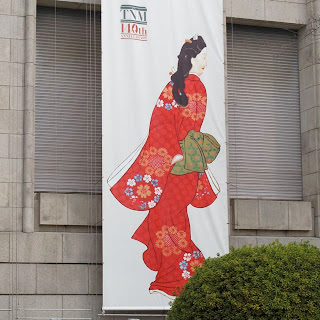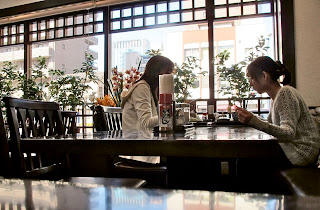 |
| Poster at the Tokyo National Museum |
I was among the Japanese for hardly more than a week. I can't claim to know them after so short a time. However, they seem a most orderly, self-sufficient people. They look smart and well groomed. Having seen in the Tokyo National Museum centuries-old
books on how to care for one's appearance, I believe this must go back many generations; it certainly has a lot to do with their upbringing. The children, even the pre-school children, are uniformly dressed in neat clothes and behave in a docile manner. Little girls wear school hats and clean socks. Elderly ladies do not go grey, but have black, dyed hair. I saw some ladies, not only the ones attending wedding parties, wearing
kimonos around town and the traditional
clogs on their feet. They look lovely, but I doubt if it's easy to walk in them.
 |
Mitsokushimae underground station
with floor tiles for blind people
to walk along
|
Japanese women tend to stay at home to look after the housework and their children; the ones who do go to work wear tailored suits or dark-coloured dresses. The male commuters are nearly all clad in black suits. This looks like a serious, disciplined nation. Our hotel was close to the IBM offices. We watched the employees coming up the escalators and striding along the metro station corridors on their way to and from work, travelling in ones, making no eye contact. We saw no pushing and shoving. Gangs of construction workers dress differently, in bandit-like headscarves and baggy, wide-bottomed trousers.
The citizens of Tokyo appear to work till they drop. In the evening the men return home after 8 p.m., pale and exhausted. Their eyes close and often they fall asleep on the underground trains despite the constantly broadcast announcements about the next station and how to behave there. A majority of people wear disposable facemasks, ostensibly to guard against germs, but I suspect also as a barrier to too much social contact. After a few days' observation I'd come to the conclusion that they must be a nation of introverts. At breakfast time (the Parisian style coffee and croissant is a popular choice) and in the lunch hours Japanese office workers often eat on their own at solitary tables in "hole-in-the-wall" restaurants, immersed in a book and / or smoking. Smoking is generally allowed indoors, but not on the street, unless you are in a designated smokers' area.
 |
| Lunchtime at a quiet restaurant in the business district |
We witnessed no graffiti and no rowdiness. We did see teenage boys studying together and trying to get their homework done. The Japanese seem to have a sense of pride in their work. At any rate, the standards of service in Tokyo are excellent. Every place that deals with the public is well manned. The servers behind the counters in cafés were gracious, repeating the standard polite phrases to every customer and proffering change in two cupped palms, hands together, with a little bow. We watched two besuited gentleman saying goodbye to a third on the platform of an underground station; they made a whole series of obeisances to him as his train pulled away. The
bowing is ubiquitous. After a day or two, Chris and I were doing it ourselves!
 |
| Street in Shirakawa, Tokyo |
City streets are kept incredibly clean (by teams of uniformed sweepers such as we saw in China) and smooth. No paving stones to trip over here as there suddenly was in Reading when we landed back in the UK (along Caversham Road Chris tripped and fell flat on his face, grazing his knee.) On the streets of Tokyo are grooved paving stones to guide the blind towards and across every pedestrian crossing. The underground stations, with their colour coded, numbered exits, entrances, multiple maps and indicators, labelled in Japanese and English, are mopped clean at regular intervals. We were very impressed by this and as foreigners felt reassured by the efforts that had been made to make the
complex network
easy to follow. Goodness knows, other nations could learn from the standards set by the Japanese in public transportation!
 |
| Cars parked in Shirakawa, a residential area |
I assume they feel they have to be efficient because their cities are so huge. Even after our exposure to Beijing and Shanghai last year, the vastness of Tokyo came as a shock. Not a corner of space in the city is wasted. Buildings are squeezed between buildings in peculiar, three-dimensional shapes. They were constructing a wedge shaped one near our hotel adjoining the network of flyovers; under the great concrete pillars of those main roads was a playground for children, used by a local school for football lessons. It's noisy, dark and polluted there, but at least the children have somewhere to run around. In the residential districts there is rarely room for a private garden so people put rows of plant pots outside their front doors. In the suburbs they have room for bonsai trees and topiary around the gravel paths beside their homes. Cars in the city are parked one above the other in tiered garages. In parking spots beyond the garages, the Japanese never fail to park their vehicles facing forwards.






No comments:
Post a Comment